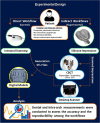The precision of two alternative indirect workflows for digital model production: an illusion or a possibility?
- PMID: 37046002
- PMCID: PMC10329612
- DOI: 10.1007/s00784-023-04996-2
The precision of two alternative indirect workflows for digital model production: an illusion or a possibility?
Abstract
Objective: Despite the clear drive from both research and clinical dentistry toward digital transformation, there are limitations to implementing intra-oral scanning (IOS) into daily dental practice. This study aimed to compare the precision of digital models obtained from two alternative indirect workflows to direct IOS.
Material and methods: Two indirect digital workflows were evaluated in this study. In the IOS group (direct), IOS directly obtained digital impressions of participants' upper and lower dental arches, while in the Scan Impression (Scan Imp) group (indirect), a desktop scanner scanned silicone-based impressions of upper and lower whole arches that were taken with plastic trays. In the cone-beam computed tomography impression (CBCT Imp) group (indirect), a CBCT machine scanned the silicone-based impressions. Then, the precision of the entire arch and individual teeth for all digital impressions was virtually quantified. Following superimposition, differences between standard tessellation language (STL) files obtained from both-direct and indirect-methods were evaluated by color-mapping and measuring the surface distance between superimposed STL files. Furthermore, 18 linear measurements were taken from each digital model. ANOVA with repeated measures, Pearson coefficient, and intraclass correlation coefficient were used for intergroup comparisons.
Results: The digital models obtained from the two indirect workflows differed from the IOS in some dental and intra-arch measurements but were considered clinically acceptable. Ranked against IOS, CBCT Imp models had greater precision, followed by Scan Imp.
Conclusion: Digital models obtained from two indirect, alternative workflows, desktop, and CBCT scanning of impression, have clinically acceptable accuracy and reliability of tooth size and intra-arch measurements, providing the use of proper methodologies.
Clinical relevance: There are some limitations to implementing IOS in daily clinical practice. However, several alternative digital model production techniques might provide an affordable solution. Although they may insignificantly differ in accuracy, all can be applied clinically.
Keywords: CBCT; Desktop scanning; Digital; Digital model; Intraoral scanner; Precision.
© 2023. The Author(s).
Conflict of interest statement
The authors declare no competing interests.
The authors declare no competing interests.
Figures



Similar articles
-
Positional trueness of abutments by using a digital die-merging protocol compared with complete arch direct digital scans and conventional dental impressions.J Prosthet Dent. 2024 Feb;131(2):293-300. doi: 10.1016/j.prosdent.2022.02.020. Epub 2022 Apr 13. J Prosthet Dent. 2024. PMID: 35430047
-
Error propagation from intraoral scanning to additive manufacturing of complete-arch dentate models: An in vitro study.J Dent. 2022 Jun;121:104136. doi: 10.1016/j.jdent.2022.104136. Epub 2022 Apr 20. J Dent. 2022. PMID: 35460866
-
Influence of abutment tooth geometry on the accuracy of conventional and digital methods of obtaining dental impressions.J Prosthet Dent. 2017 Sep;118(3):392-399. doi: 10.1016/j.prosdent.2016.10.021. Epub 2017 Feb 17. J Prosthet Dent. 2017. PMID: 28222873
-
Intraoral scanners in implant prosthodontics. A narrative review.J Dent. 2024 Sep;148:105152. doi: 10.1016/j.jdent.2024.105152. Epub 2024 Jun 22. J Dent. 2024. PMID: 38909643 Review.
-
Influence of Tooth Preparation Design and Scan Angulations on the Accuracy of Two Intraoral Digital Scanners: An in Vitro Study Based on 3-Dimensional Comparisons.J Prosthodont. 2020 Mar;29(3):201-206. doi: 10.1111/jopr.13148. Epub 2020 Feb 13. J Prosthodont. 2020. PMID: 31994818 Review.
Cited by
-
Attitudes of dentists and patients towards the introduction of artificial intelligence in dentistry.J Med Life. 2025 May;18(5):472-477. doi: 10.25122/jml-2024-0382. J Med Life. 2025. PMID: 40599148 Free PMC article.
References
MeSH terms
Substances
LinkOut - more resources
Full Text Sources

